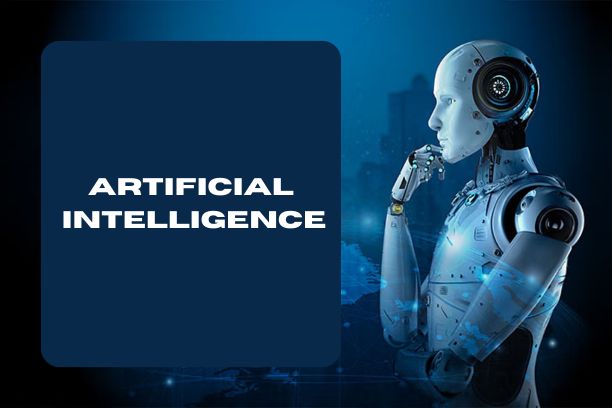
Artificial Intelligence (AI): Definitions, Advantages, Disadvantages, Types, Usage and More
This article explores the evolving expedition of artificial intelligence (AI) from its institution to today. It covers major milestones in AI development, including breakthroughs in machine learning, natural language processing, and neural networks. It aims to provide readers with a comprehensive understanding of the role of AI in our world and the responsibilities that come with it.
Artificial intelligence (AI) can be defined in many different ways depending on the context

Source: FIRST Community
General definition: AI refers to the speculation of human intelligence which began to think and act like humans. Such as learning, thinking logically, problem-solving, penetration, and language understanding.
Narrow AI: This type of AI is created to achieve a specific task or a narrow range of tasks. Narrow AI does not have general intelligence or consciousness.
General AI: This abstraction is also known as AGI (Artificial General Intelligence) and it is a type of AI that can understand, learn, and evolve intelligence at a human-like level in the future. It will be used for a comprehensive function. AGI is still theoretical in nature at this time.
Machine learning: A branch of AI that involves the use of algorithms and statistical models to enable machines to improve their performance of certain tasks through experience, without being explicitly programmed.
Deep learning: A specialized form of machine learning that uses multi-layered neural networks (deep networks) to analyze different data elements.
Cognitive computing: It deals with AI systems that imitate thought processes to understand and respond to complex data. It often incorporates elements such as natural language processing and machine learning.
Advantages of Artificial Intelligence
Efficiency and automation: AI can automate repetitive tasks, improving productivity and allowing human employees to focus on more complex, value-added activities.
Data analytics: AI can process and analyze large amounts of data quickly and accurately, identifying patterns and insights that humans often miss.
Improved decision-making: AI systems support the decision-making process by providing data-driven recommendations and predictive analytics, helping organizations make more informed decisions.
Personalization: AI can improve user experience by personalizing services and products, such as tailored recommendations in e-commerce or customized content in streaming services.
Cost Reduction: AI automates processes and improves efficiency, leading to significant cost savings for companies.
Availability: Unlike humans, AI systems can work continuously without fatigue, making them ideal for applications like customer support and monitoring.
Improved Accuracy: AI reduces human error in tasks like data entry, diagnostics, and complex calculations, resulting in better results.
Scalability: AI solutions can easily scale up or down to adapt to changing needs, allowing companies to quickly adapt to market conditions.
Innovation: AI can drive innovation by enabling new products, services, and business models, fostering creativity, and improving competitive advantage.
Safety and Risk Management: In sectors like manufacturing and healthcare, AI can help predict and mitigate risks, improve safety protocols, and reduce accidents.
These benefits make AI a powerful tool in a variety of sectors, including healthcare, finance, manufacturing, and entertainment.
Disadvantages of Artificial Intelligence

Source: URBE University
Job Loss: The automation of tasks may lead to job losses in certain sectors, especially for low-skilled workers, raising concerns about unemployment and economic inequality.
Bias and Fairness: AI systems may perpetuate or exacerbate biases in their training data, leading to unfair outcomes in areas such as hiring, lending, and law enforcement.
Lack of transparency: Many AI models, especially deep learning systems, operate like “black boxes,” making it difficult to understand how decisions are made and potentially undermining accountability.
High cost: AI technologies can be expensive to develop and implement, requiring significant investments in hardware, software, and human resources.
Data Dependence: Substandard or inadequate data can lead to imprecise models and prophecies.
Vulnerability Risk: AI can be vulnerable to adversarial attacks in which malicious actors exploit weaknesses in AI systems, potentially leading to harmful outcomes.
Ethical concerns: The use of AI raises a range of ethical issues, including privacy concerns, surveillance and potential misuse in areas such as military applications and autonomous weapons.
Loss of the human touch: In areas such as customer service and healthcare, reliance on AI can lead to a loss of personal interaction, which some users may find unsatisfying.
Overreliance: Overreliance on AI in decision-making can undermine critical thinking and human judgment, leading to negative outcomes if the AI system breaks down.
Regulatory and Legal Challenges: The rapid development of AI technology may overtake existing laws and regulations, raising challenges around governance, accountability, and responsibility.
These shortcomings highlight the importance of responsible development and implementation of AI to ensure that the benefits of AI are balanced with ethical considerations and societal impacts.
AI can be classified in different ways depending on its capabilities and functions
Narrow AI (Weak AI): Generated to execute specific tasks. She works in limited contexts and does not have general intelligence.
General AI (Strong AI): A theoretical form of AI that can understand, learn, and apply intelligence across a wide range of tasks, similar to human cognitive capabilities. It doesn’t yet exist.
Super intelligent AI: An advanced AI that exceeds human intelligence in all areas, including creativity, problem-solving, and social skills. This is still speculation.
Reactive Machines: Simple AI systems that respond to specific inputs with pre-programmed outputs without learning from previous experience (such as IBM’s Deep Blue).
Limited Memory: AI systems that can learn from past data to improve their performance over time (such as self-driving cars).
Theory of Mind: An evolving field of AI research focused on developing systems that can understand human emotions, beliefs, and intent.
Self-Aware AI: Theoretic AI that is self-aware and conscious.
These categories highlight diverse capabilities and possibilities of current and future AI technology.




